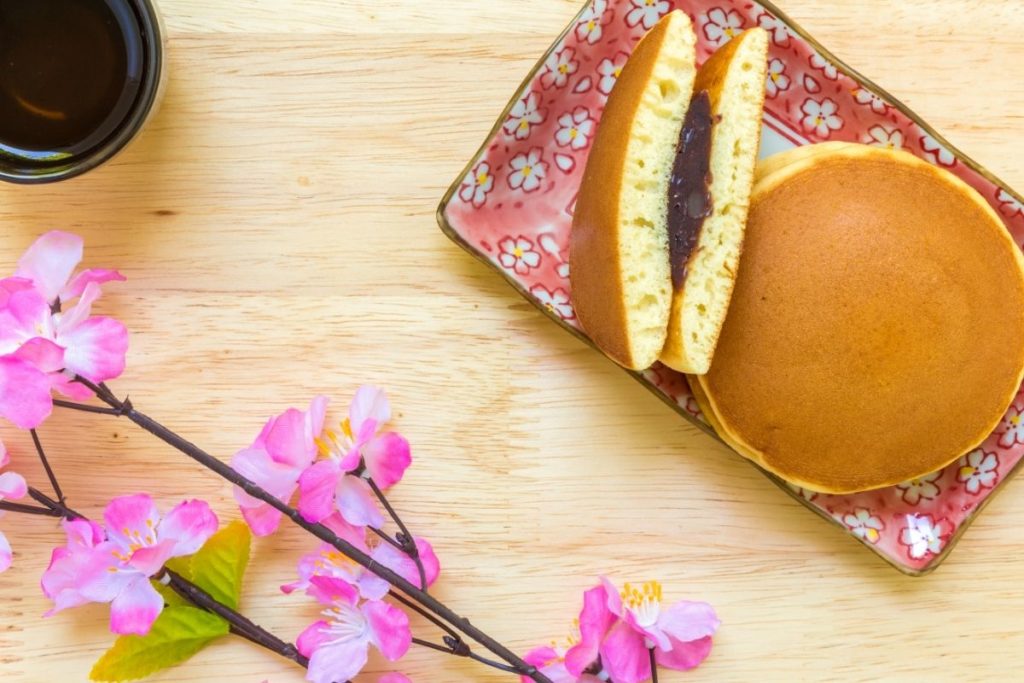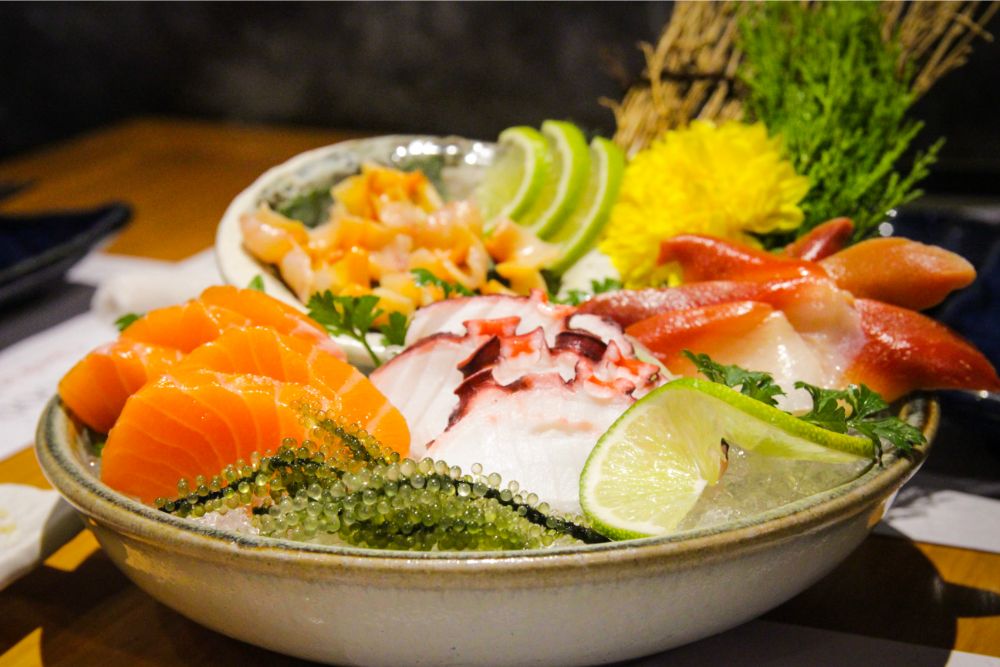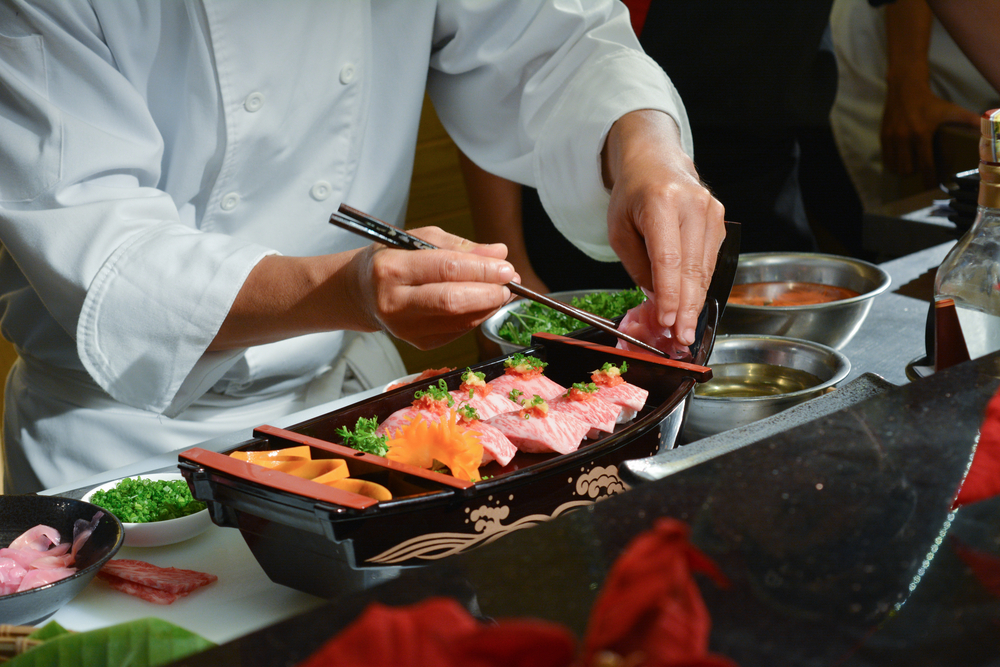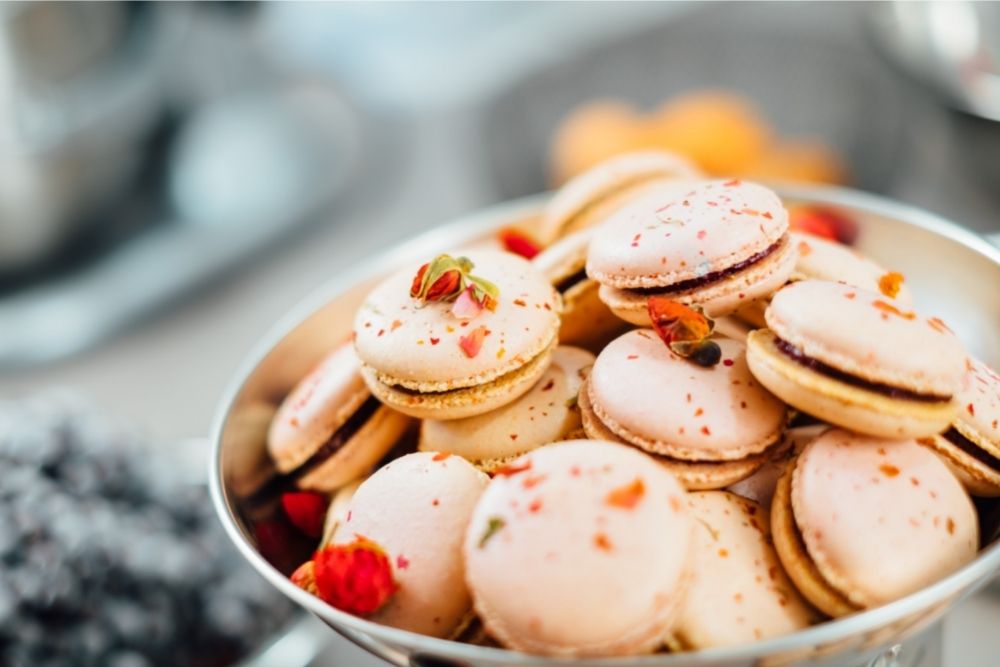Japanese cuisine has taken the world by storm. The world’s best and brightest cities have high-end sushi restaurants scattered across them, and noodle bars hidden like gems.
What is sometimes overlooked, though, are the hundreds of delicious traditional Japanese desserts. These deserve just as much attention as savoury dishes like sushi and ramen.

Japanese desserts are unlike any other, and that is predominantly because of the ingredients used to make them.
For many years, sugar was not available in most parts of Japan. That wasn’t going to stop people from creating delicious sweet treats, though. The people of Japan managed to concoct delicious desserts without sugar. This led to most traditional sweet dishes including alternative ingredients, like rice and beans.
In addition, this means that a number of common Japanese desserts are gluten free or dairy free – or both.
In general, traditional Japanese desserts, otherwise known as wagashi, are unique and aesthetic treats that are perfect for bringing a meal to a delightful close.
Take a look below, where we explore twenty-two of our favourite, most mouth-watering traditional Japanese desserts.
Dorayaki
First on the list is a dish that slightly resembles our western pancakes. The sweet treat comprises two pancakes, which are sandwiched together with an anko filling. Anko is a paste made from Japanese azuki beans, which are sweet beans that often crop up in Japanese desserts.
These days, anko often includes honey or sugar, and is a key component in dozens of other Japanese dishes. Some dorayaki simply have anko as the filling, while others have additional ingredients, like ice cream and chestnuts.
You can basically tailor this dessert to include all your favourite fillings, which is one of the best things about it!
If you live in the Queensland capital and fancy some Japanese food, why not check out our restaurant guide?
Coffee Jelly
Made from ground coffee and covered in cream, this dessert is the perfect pick-me-up after a filling lunch. The bitter taste of the coffee is complemented perfectly by the sweetness of cream, and the overall texture is soft and delicate.
I don’t know about you, but I would much rather have one of these than an espresso digestif.
Manju
This is the second dessert on the list that utilises naturally sweet beans to flavour it. Otherwise known as red bean cakes, these little treats look a little like steamed dumplings, However, they have a sweet anko paste instead of a meaty filling.
These bite-sized traditional Japanese desserts are as fluffy as clouds, but a few of them should be filling enough to satiate you.
Mochi
This is probably the most popular Japanese treat, or at least the one that is most recognised by westerners. They are a dessert or snack in and of themselves, but are also included as an element of multiple other desserts. The main ingredient in mochi is a type of sticky rice, called mochigome.
This rice is repeatedly pounded until it forms a sort of dough. These chewy round delights are a Japanese favourite. There are different types of mochi for every occasion. Many significant days in the Japanese calendar have been assigned their own unique mochi.
For example, to celebrate spring and Japan’s beloved cherry blossom trees, a pink sakura mochi is enjoyed throughout the country.
Be careful to chew carefully when you eat mochi, though; they are so dense and chewy that they are actually responsible for hundreds of choking-related hospitalisations every year. Stay safe!
For some Japanese restaurant recommendations in Melbourne, see here.
Dango
Similar to mochi, the main ingredient in this dessert is rice. Some of you may have seen them served on sticks, which makes them look just like marshmallows. In fact, many people even roast them over an open fire to get a toasted skin, just like we do with marshmallows.
They can be eaten by themselves, but are most commonly enjoyed accompanied by a sweet topping. One of the most popular toppings is shoyu, which is a sticky glaze made from sugar and starch.
Like mochi, there are endless varieties of dango; you can get them in pretty much every colour under the sun. As well as filling people’s bellies, these desserts have also inspired a Japanese hairstyle called ‘odango’, which is similar to what we might call ‘space buns’.
Namagashi
This is not the name of one particular dessert, but rather of a category of Japanese desserts. This category is comprised of any type of sweet treat that looks aesthetically pleasing enough to be brought to a Japanese tea ceremony. These sweets must be freshly made, and are often very small.
Common ingredients found in namagashi include anko and fruit jelly. These desserts are thought of more as art than merely as a dessert, and this is reflected in the endless array of namagashi designs that are available throughout the year.
These are most commonly eaten with a cup of matcha tea.
We adore ramen in our house. see here for some of the best ramen in Perth.
Higashi
Higashi is a small sweet treat that is often served alongside Namagashi, but which is completely different from it. Instead of being made from fresh ingredients, higashi is a category of sweets that contain no fresh ingredients, and which are thus very long lasting.
They are equally as fancy and artistic as namagashi, and can also be found at prestigious events like tea ceremonies. However, higashi are more similar to western cookies than they are to our desserts.
They are available in unlimited shapes and sizes, as well as multiple colours. Pretty much any concept can be made into higashi. They are one of the more versatile traditional Japanese desserts.
Castella
These cakes sound more European than Japanese, and for good reason. Although they have been around in Japan for hundreds of years now, they originated from Portugal. Castella is a spongey, light cake, which is often used to make Japanese pancakes – for example those in dorayaki.
The edges of the cakes tend to be browned and slightly crispy, while the main bulk of the sponge is light and fluffy.
One of the main ingredients in castella is sugar, which meant that until recently it was rarely available to the wider public in Japan, and was predominantly enjoyed by wealthy aristocrats who had access to sugar.
Luckily for us commoners, sugar is now widely available, and thus so are these delicious cakes!
Looking for ramen in Sydney? Let us guide you.
Mochi Ice Cream
One of the desserts that uses mochi as a core ingredient is mochi ice cream. Balls of ice cream are covered in a coat of mochi dough, then coated with a sprinkle of corn starch. This dessert was developed in the 80s, so is not exactly traditional, but it is certainly widely loved in Japan.
Is all this talk about mochi making you hungry for a Japanese feast? If you live in Perth, here’s a few dining suggestions for you.
Yokan
Yokan is a type of dense jelly, which is often cut into small rectangles. It is made in a rainbow of colours. The jelly is sometimes made from bean paste – either red bean or white bean – and agar.
Agar is what creates the bulk of the jelly texture. It is a natural plant-derived alternative to gelatin. Agar can easily be injected with flavour, so there is yokan available with all sorts of tastes.
These little bites of heaven are found in pretty much every Japanese souvenir shop, and are perfect for bringing home to your friends and family as little gifts.
Honey Toast
This next dessert looks as amazing as it tastes. A huge slab of fluffy bread is caramelised and topped with lashings of butter and honey. It is a little bit like french toast, in many ways, but – personally – we think this has more of a wow factor.
When we say this dish consists of a huge slab of bread, we mean it; the piece of bread that this dessert centres around is about the size of a whole loaf!
This might sound like too much, but the moisture that it soaks up from the butter and honey makes it melt in the mouth and almost dissolve onto your tongue.
It can be topped with pretty much anything else you fancy, and many Japanese customers opt for a scoop of ice cream and some fruit alongside the honey and butter. This dish can be eaten after a meal, and is also frequently used as an alternative to birthday cakes.
Sydney has some outstanding Japanese restaurants. These are just some of them.
Japanese Cheesecake
You have probably seen those giant, wobbly, fluffy cheesecakes that frequently go viral on Instagram. They look like gravity-defying giant pancakes, but are actually Japanese cheesecakes.
They are renowned for their light-as-a-feather texture and insanely jiggly body, and are one of Japan’s most famous desserts. The unmatched airiness of these cakes comes from perfectly whipping egg whites into the pancake batter.
This dish is sold across Japan, and is now also found in restaurants all over the United States, but is surprisingly easy to make at home, too.
Although it is called a cheesecake, it is like a mixture of a souffle, pancake, and cheesecake. And let me tell you, that is a winning combination in our book!
Daigaku Imo
Daigaku Imo are sweet potatoes that have been dessert-ified by being candied and deep-fried. This dish is particularly popular in the colder months, and is a staple Japanese comfort food.
The process is simple. Chop sweet potatoes into small chunks, deep-fry them and then smother them in a gooey caramel sauce. The already sweet flavour of the vegetable is heightened and complemented perfectly by the sweet syrup.
The best thing about this dessert is its variety of textures; the soft inside of the potato is met with the crisp texture of the potato skin, which is then augmented by the crunch of the caramel.
Each mouthful of this dish is a complete delight, and we don’t know how it’s not more popular overseas. Unlike the previously scarce supply of Castella, Daigaku Imo has always been enjoyed across the Japanese nation.
Sweet potatoes were and still are very cheap ingredients, so people from all walks of life have been able to experience the deliciousness of Daigaku Imo for years.
See here for some spots to try ramen in Melbourne.
Kinako Dusted Tofu
Kinako is a type of flour made from roasted soybeans. It is commonly used in Japanese dishes, and is an essential part of these traditional Japanese desserts. It was often used as a sweetener back when sugar wasn’t widely available.
This dish is quick and simply to make, and has tasty results. Just drain and slice the tofu, before topping it with a sprinkling of kinako and your choice of syrup.
The most commonly used syrup in Japan for this dish is kuromitsu sugar syrup. Alternatively, the old faithful bean past, anko, is equally as delicious with the tofu.
Mizu-Yokan
Otherwise known in Japan as kashi, this dessert originated from China but has been in Japan for many centuries. It is a traditional Japanese jelly, whose main ingredient is agar.
Mizu-Yokan is exactly like regular yokan, but it has much more water in it. The increased water content makes this dessert more refreshing than traditional yokan, which is why it is often served during the hotter months.
Brisbane has some great ramen shops. Here are a few of our go-tos.
Matcha Ice Cream
Matcha is Japan’s most well known type of green tea powder, and is now drunk and enjoyed all over the world. The flavour of matcha is unique, but can be described as refreshing.
When used to make ice cream, the result is a soothing and light dessert that is unlike any other type of ice cream. Green tea is renowned for its health benefits, so eating matcha flavoured ice cream almost feels like you’re being really healthy.
Read our review of Ichiro Izakaya Bar here.
Taiyaki
When you taste this dessert, you may find the flavours surprising, considering the way it is presented…This dessert is a type of cake, which is uniquely molded into the shape of a fish! This bizarre twist makes the sweet flavours of the cake all the more delightful.
The main part of the cake is not the batter, but actually the filling of the cake, which is where the predominant flavors come from. The versatile red bean paste is frequently used to fill these fishy cakes, but you can also find pretty much any other type of filling in them, too.
Sweet potato can make an appearance in this dessert, as can chocolate, tofu, and even cheese. Taiyaki can also be made into a savoury snack, when it is filled with meat like sausage and pork.
Few dining experience can rival the theatre of Teppanaki. Here are some of the best spots for this treat in Melbourne.
Imagawayaki
Next up is a dish that strongly influenced the development of taiyaki. It has the same cake batter exterior, and is commonly filled with anko.
The main difference between imagawayaki and taiyaki is that, instead of the unique fish shape, imagawayaki has a round shape and a slightly crisped outer layer. Like its predecessor, this cake can be filled with all kinds of things, including custard, fruit, and cheese.
If you find yourself in Daylesford, check out the wonderful Kadota Restaurant for seasonal Japanese food at its finest.
Kakigori
This dessert is particularly popular during hot summer months. It is refreshing, cooling, and comes in a huge range of flavours. Kakigori is a mound of fresh shaven ice, which is then covered in your choice of fruit syrup.
It may not sound like much, but it is actually full of flavour! Unlike other desserts, kakigori won’t fill you up or leave you feeling bloated, and is a low-calorie alternative to ice cream or sorbet.
Has this article made you interested in our Asian dessert recipes? If so, why not take a look at our Best Filipino Desserts.
Uiro
Particularly popular in the Japanese city of Nagoya, this bite-sized treat is made from sugar and rice flour. The result of mixing these ingredients is a chewy and sticky cake.
A variety of different flavours are added to the two main ingredients to make these available in all sorts of flavours, ranging from fruit to matcha, to chestnut. There is an uiro out there for everyone!
Purin
Last, but not least, on our list is a dessert that is reminiscent of Mexican flan or American custard puddings. It is served cold, so is perfect if you are looking for a refreshing treat on a hot day. It’s texture is smooth and silky, but slightly firmer than a flan.
The main ingredients are milk, sugar, eggs, and vanilla, and the dessert is so popular that there are packets of instant purin mix widely available in grocery stores all over Japan.
Purin is not cooked regularly in the oven or on the stove, but is instead formed in a water bath which is heated in the oven. The best part of this dessert is the sweet caramel sauce that is drizzled on top.
Final Thoughts
Nearly all of these traditional Japanese desserts are made from natural ingredients, many of which act as alternatives to sugar. Even though sugar is now widely available across the country, Japan’s traditional desserts are still as popular – and delicious – as ever.
So many traditional Japanese desserts utilise the sweetness of beans to flavour them; around half of the dishes on this list contain a type of anko, or bean paste. So, before you order a load of Japanese sweet treats, you might want to make sure you like the taste of anko!
If you don’t – that’s fine! There are plenty of fabulous desserts that don’t include the sugar alternative. Purin, Kakigori, Matcha ice cream, and Castella are just a few of Japan’s sweet dishes that refrain from the use of anko.
Just like the rest of Japanese cuisine, its desserts are varied, versatile, and don’t disappoint.
- The 15 Best Chinese Restaurants In Melbourne - May 1, 2024
- The 15 Best High Tea Venues In Melbourne - April 30, 2024
- Orange Cake - April 23, 2024








